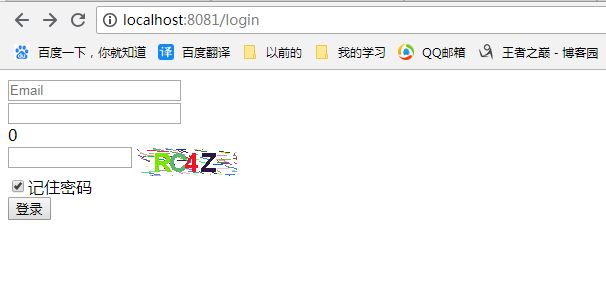今天我们完成框架的thymeleaf模板显示页面功能,页面的用户登陆,密码的AES加密解密,输错3次进行验证码验证功能,东西可能比较多,这个是我这两天在网上结合各种资源整合出来的,基本功能都已经实现,项目代码我会附在文章的最后面。
1.thymeleaf模板显示页面功能
org.thymeleaf thymeleaf 3.0.9.RELEASE org.thymeleaf thymeleaf-spring4 3.0.9.RELEASE org.springframework.boot spring-boot-starter-thymeleaf
在customer模块的resources下创建static、templates文件夹,如下:
在static下放置一些页面样式的js和css,在templates文件夹下放置html页面,此时在resources下的application.properties配置文件中配置thymeleaf,
#thymelea模板配置 spring.thymeleaf.prefix=classpath:/templates/ spring.thymeleaf.suffix=.html spring.thymeleaf.mode=HTML5 spring.thymeleaf.encoding=UTF-8 #热部署文件,页面不产生缓存,及时更新 spring.thymeleaf.cache=false spring.resources.chain.strategy.content.enabled=true spring.resources.chain.strategy.content.paths=/**
此时thymeleaf模板就配置完成了。
2.页面的用户登陆,AES加密解密:
关于AES的加密解密,我的实现思路是:首先用户在浏览器中输入网址跳转到登录页面,此时在页面中已经保存了从后台传过来的key,该key值是后台随机生成的,后台session中保存key值,前台页面的隐藏框中也要保存key值,用于前端页面的密码加密以及后端的密码解密,页面刷新或用户名、密码输入错误时,都会重新生成新的key值来替换原有保存的key。
首先在pom.xml中添加依赖:
com.alibaba fastjson 1.2.28 commons-codec commons-codec 1.10
用AES加密解密
a.前端加密用到的js有:aes.js和mode-ecb-min.js,就为了下载这两个js花了我30个积分呢,[/哭],可以在static文件夹下创建一个aes文件夹,用于放置这两个js。js下载地址:https://download.csdn.net/download/weixin_38340967/10677798
在templates下创建login.html,代码如下:
"http://www.w3.org/1999/xhtml" xmlns:th="http://www.thymeleaf.org" xmlns:sec="http://www.thymeleaf.org/thymeleaf-extras-springsecurity3"> "UTF-8">welcome "hidden" id="KEY" th:value="${model.loginToken}" />
这里有一个坑,就是在html页面中引入js的时候路径的问题,可以看到我在页面中是这样写的:,但是你仔细看应该是才对,为什么会少一个static呢,这是因为thymeleaf模板本身引入js时的路径就是默认在static下的,要是加上static反而页面会报js404错误,不信大家可以试试看。
var key = $('#KEY').val();
// alert("key的值是: "+key);
key = CryptoJS.enc.Utf8.parse(key);
// alert("加密后key的值是: "+key);
p = CryptoJS.enc.Utf8.parse($.trim(p));
var encrypted = CryptoJS.AES.encrypt(p, key, {mode:CryptoJS.mode.ECB,padding: CryptoJS.pad.Pkcs7});
param.password = encrypted.toString();
这段代码就是通过AES将用户输入的明文密码和后台传过来的key加密成密文,放到input框中提交到后台。
b.后台生成随机的key值,并将前台传过来的密文解密成明文密码,
这里要在common模块中写几个工具类:EncryptUtil用于密码的加密解密,Helper用于记录一些常量,RandomUtil用于随机生成key值,Result用于向前台返回一个结果对象,样式如下:
工具类代码如下:
EncryptUtil:
package com.lj.common.util; import javax.crypto.Cipher; import javax.crypto.KeyGenerator; import javax.crypto.spec.SecretKeySpec; import org.apache.commons.codec.binary.Base64; import sun.misc.BASE64Decoder; import java.security.SecureRandom; /** * Created with IntelliJ IDEA. * User: gaopeng * Date: 2018/9/17 0017 * Time: 17:30 * Description: */ public class EncryptUtil { private static final String KEY = "abcdefgabcdefg12"; private static final String ALGORITHMSTR = "AES/ECB/PKCS5Padding"; public static String base64Encode(byte[] bytes){ return Base64.encodeBase64String(bytes); } public static byte[] base64Decode(String base64Code) throws Exception{ return new BASE64Decoder().decodeBuffer(base64Code); } public static byte[] aesEncryptToBytes(String content, String encryptKey) throws Exception { KeyGenerator kgen = KeyGenerator.getInstance("AES"); kgen.init(128); Cipher cipher = Cipher.getInstance(ALGORITHMSTR); cipher.init(Cipher.ENCRYPT_MODE, new SecretKeySpec(encryptKey.getBytes(), "AES")); return cipher.doFinal(content.getBytes("utf-8")); } public static String aesEncrypt(String content, String encryptKey) throws Exception { return base64Encode(aesEncryptToBytes(content, encryptKey)); } public static String aesDecryptByBytes(byte[] encryptBytes, String decryptKey) throws Exception { KeyGenerator kgen = KeyGenerator.getInstance("AES"); SecureRandom secureRandom = SecureRandom.getInstance("SHA1PRNG" ); secureRandom.setSeed(decryptKey.getBytes()); kgen.init(128,secureRandom); Cipher cipher = Cipher.getInstance(ALGORITHMSTR); cipher.init(Cipher.DECRYPT_MODE, new SecretKeySpec(decryptKey.getBytes(), "AES")); byte[] decryptBytes = cipher.doFinal(encryptBytes); return new String(decryptBytes); } public static String aesDecrypt(String encryptStr, String decryptKey) throws Exception { return aesDecryptByBytes(base64Decode(encryptStr), decryptKey); } /** * 测试 * */ public static void main(String[] args) throws Exception { String content = "Test String么么哒"; //0gqIDaFNAAmwvv3tKsFOFf9P9m/6MWlmtB8SspgxqpWKYnELb/lXkyXm7P4sMf3e System.out.println("加密前:" + content); System.out.println("加密密钥和解密密钥:" + KEY); String encrypt = aesEncrypt(content, KEY); System.out.println(encrypt.length()+":加密后:" + encrypt); String decrypt = aesDecrypt(encrypt, KEY); System.out.println("解密后:" + decrypt); } }
Helper:
package com.lj.common.util; /** * Created with IntelliJ IDEA. * User: gaopeng * Date: 2018/9/17 0017 * Time: 17:08 * Description: */ public class Helper { public static final String SESSION_CHECKCODE = "SESSION_CHECKCODE"; public static final String SESSION_LOGIN_TOKEN = "SESSION_LOGIN_TOKEN"; public static final String SESSION_USER = "SESSION_USER"; public static final String SESSION_LOGIN_FAILURE_COUNT = "SESSION_LOGIN_FAILURE_COUNT"; public static final String logTypeSecurity = "logTypeSecurity"; public static final Integer COUNT = 3; }
RandomUtil:
package com.lj.common.util; import java.util.Random; /** * Created with IntelliJ IDEA. * User: gaopeng * Date: 2018/9/17 0017 * Time: 17:22 * Description: */ public class RandomUtil { public static final String ALLCHAR = "0123456789abcdefghijklmnopqrstuvwxyzABCDEFGHIJKLMNOPQRSTUVWXYZ"; public static final String LETTERCHAR = "abcdefghijkllmnopqrstuvwxyzABCDEFGHIJKLMNOPQRSTUVWXYZ"; public static final String NUMBERCHAR = "0123456789"; /** * 返回一个定长的随机字符串(只包含大小写字母、数字) * * @param length * 随机字符串长度 * @return 随机字符串 */ public static String generateString(int length) { StringBuffer sb = new StringBuffer(); Random random = new Random(); for (int i = 0; i < length; i++) { sb.append(ALLCHAR.charAt(random.nextInt(ALLCHAR.length()))); } return sb.toString(); } /** * 返回一个定长的随机纯字母字符串(只包含大小写字母) * * @param length * 随机字符串长度 * @return 随机字符串 */ public static String generateMixString(int length) { StringBuffer sb = new StringBuffer(); Random random = new Random(); for (int i = 0; i < length; i++) { sb.append(LETTERCHAR.charAt(random.nextInt(LETTERCHAR.length()))); } return sb.toString(); } /** * 返回一个定长的随机纯大写字母字符串(只包含大小写字母) * * @param length * 随机字符串长度 * @return 随机字符串 */ public static String generateLowerString(int length) { return generateMixString(length).toLowerCase(); } /** * 返回一个定长的随机纯小写字母字符串(只包含大小写字母) * * @param length * 随机字符串长度 * @return 随机字符串 */ public static String generateUpperString(int length) { return generateMixString(length).toUpperCase(); } /** * 生成一个定长的纯0字符串 * * @param length * 字符串长度 * @return 纯0字符串 */ public static String generateZeroString(int length) { StringBuffer sb = new StringBuffer(); for (int i = 0; i < length; i++) { sb.append('0'); } return sb.toString(); } /** * 根据数字生成一个定长的字符串,长度不够前面补0 * * @param num * 数字 * @param fixdlenth * 字符串长度 * @return 定长的字符串 */ public static String toFixdLengthString(long num, int fixdlenth) { StringBuffer sb = new StringBuffer(); String strNum = String.valueOf(num); if (fixdlenth - strNum.length() >= 0) { sb.append(generateZeroString(fixdlenth - strNum.length())); } else { throw new RuntimeException("将数字" + num + "转化为长度为" + fixdlenth + "的字符串发生异常!"); } sb.append(strNum); return sb.toString(); } /** * 每次生成的len位数都不相同 * * @param param * @return 定长的数字 */ public static int getNotSimple(int[] param, int len) { Random rand = new Random(); for (int i = param.length; i > 1; i--) { int index = rand.nextInt(i); int tmp = param[index]; param[index] = param[i - 1]; param[i - 1] = tmp; } int result = 0; for (int i = 0; i < len; i++) { result = result * 10 + param[i]; } return result; } }
Result:
package com.lj.common.util; import java.util.Date; /** * Created with IntelliJ IDEA. * User: gaopeng * Date: 2018/9/17 0017 * Time: 18:26 * Description: */ public class Result { private Boolean success; private String msg; private String key; public Boolean getSuccess() { return success; } public void setSuccess(Boolean success) { this.success = success; } public String getMsg() { return msg; } public void setMsg(String msg) { this.msg = msg; } public String getKey() { return key; } public void setKey(String key) { this.key = key; } public Result(Boolean b, String s){ this.success = b; this.msg = s; } public Result(Boolean b, String s, String k){ this.success = b; this.msg = s; this.key = k; } }
在customer模块中的controller中拦截/login和/signIn路径的代码如下:
@GetMapping("login") public ModelAndView login(HttpServletResponse response, HttpServletRequest request, Model model){ //生成login_token HttpSession session = request.getSession(); String key = RandomUtil.generateString(16); session.setAttribute(Helper.SESSION_LOGIN_TOKEN, key);//登录令牌,用于密码加密的key,16位长度 if(session.getAttribute(Helper.SESSION_LOGIN_FAILURE_COUNT) == null){ session.setAttribute(Helper.SESSION_LOGIN_FAILURE_COUNT, Helper.COUNT);//登录剩余失败次数 } model.addAttribute("loginToken",key); System.out.println("传到前台的key值为:"+ key); System.out.println("页面跳转到login.html"); // return "login"; // if(session.getAttribute(Helper.SESSION_USER) == null){ return new ModelAndView("login","model",model); // } // else // return "redirect:/"; }
@PostMapping(value = "signIn") @ResponseBody public String signIn(String username,String password,boolean remember,String checkCode,HttpServletRequest request, HttpServletResponse response){ System.out.println(username+","+password+","+remember+","+checkCode); HttpSession session = request.getSession(); Object token = session.getAttribute(Helper.SESSION_LOGIN_TOKEN);//原始令牌 if(token==null) return JSON.toJSONString(new Result(false,"timeout"));//登录成功后token失效,则页面失效,客户端需要重定向到主界面 Object countObj = session.getAttribute(Helper.SESSION_LOGIN_FAILURE_COUNT); int count = countObj==null?3:Integer.parseInt(countObj.toString()); System.out.println("剩余次数:"+count); //验证码逻辑 if(count<=0){ //需要验证码 Object oldCode = session.getAttribute(Helper.SESSION_CHECKCODE); if(checkCode==null||oldCode==null){ //该登录界面没有验证码字段,但是已经消耗掉了剩余次数,说明该页面是过期页面,需要重新登录 System.out.println("chaoshila"); return JSON.toJSONString(new Result(false,"timeout"));//客户端需要重定向到主界面 } if(checkCode.trim().isEmpty()) return JSON.toJSONString(new Result(false,"请输入验证码")); if(oldCode.toString().equalsIgnoreCase(checkCode)){ //验证通过,可信客户端,给0次剩余次数 count=0; session.setAttribute(Helper.SESSION_LOGIN_FAILURE_COUNT,count); }else{ return JSON.toJSONString(new Result(false,"codeError"));//验证码不正确,客户端需要刷新验证码 } } //解密 try { password = EncryptUtil.aesDecrypt(password,token.toString());//解密后 System.out.println("Decrypt:"+password); } catch (Exception e) { e.printStackTrace(); return JSON.toJSONString(new Result(false,"timeout"));//客户端需要重定向到主界面 } //登录校验 String loginKey = RandomUtil.generateString(16);//重新生成登录令牌,任何登录失败的操作都需要更新登录令牌 User user = null; System.out.println(user == null); if(user == null){ session.setAttribute(Helper.SESSION_LOGIN_TOKEN,loginKey); session.setAttribute(Helper.SESSION_LOGIN_FAILURE_COUNT,--count);//剩余次数-1 System.out.println("剩余次数:" + session.getAttribute(Helper.SESSION_LOGIN_FAILURE_COUNT)); //if(count<=0) return JSON.toJSONString(new Result(false,"checkCode",loginKey));//客户端需要重定向到登录界面将验证码显示出来 System.out.println("这里直接要返回了!!!"); Result result = new Result(false,"用户名或密码错误!",loginKey); System.out.println("result对象的值是:" + result.getKey()); System.out.println(JSON.toJSONString(result)); return JSON.toJSONString(new Result(false,"用户名或密码错误!",loginKey)); }else{ // if(user.getUserid()!=ConfigInfo.admin_id && !user.getuStatus().equals(ConfigInfo.user_status_normal)) { // session.setAttribute(Helper.SESSION_LOGIN_TOKEN,key); // return JSON.toJSONString(new Result(false,"登录失败,该账号已被禁止使用!",key)); // } //登录成功 session.removeAttribute(Helper.SESSION_LOGIN_TOKEN); // loginUser = user; session.setAttribute(Helper.SESSION_USER,user); // sysEventService.insertEventLog(Helper.logTypeSecurity,username+" 登录系统"); return JSON.toJSONString(new Result(true,"登录成功!")); } }
上面生成key以及解密的部分都有注解,应该能看懂的。
c.输错3次显示验证码
这里要实现验证码功能,首先要在common中写一个工具类,用于生成验证码,代码如下:
package com.lj.common.util; import java.awt.Color; import java.awt.Font; import java.awt.Graphics2D; import java.awt.image.BufferedImage; import java.io.FileOutputStream; import java.io.IOException; import java.io.OutputStream; import java.util.Random; import javax.imageio.ImageIO; /** * Created with IntelliJ IDEA. * User: gaopeng * Date: 2018/9/17 0017 * Time: 16:57 * Description: */ public class ValidateCode { // 图片的宽度。 private int width = 160; // 图片的高度。 private int height = 28; // 验证码字符个数 private int codeCount = 4; // 验证码干扰线数 private int lineCount = 150; // 验证码 private String code = null; // 验证码图片Buffer private BufferedImage buffImg = null; private char[] codeSequence = { 'A', 'B', 'C', 'D', 'E', 'F', 'G', 'H', 'I', 'J', 'K', 'L', 'M', 'N', 'P', 'Q', 'R', 'S', 'T', 'U', 'V', 'W', 'X', 'Y', 'Z', '1', '2', '3', '4', '5', '6', '7', '8', '9' }; public ValidateCode() { this.createCode(); } /** * * @param width * 图片宽 * @param height * 图片高 */ public ValidateCode(int width, int height) { this.width = width; this.height = height; this.createCode(); } /** * * @param width * 图片宽 * @param height * 图片高 * @param codeCount * 字符个数 * @param lineCount * 干扰线条数 */ public ValidateCode(int width, int height, int codeCount, int lineCount) { this.width = width; this.height = height; this.codeCount = codeCount; this.lineCount = lineCount; this.createCode(); } public void createCode() { int x = 0, fontHeight = 0, codeY = 0; int red = 0, green = 0, blue = 0; x = width / (codeCount + 2);// 每个字符的宽度 fontHeight = height - 2;// 字体的高度 codeY = height - 4; // 图像buffer buffImg = new BufferedImage(width, height, BufferedImage.TYPE_INT_RGB); Graphics2D g = buffImg.createGraphics(); // 生成随机数 Random random = new Random(); // 将图像填充为白色 g.setColor(Color.WHITE); g.fillRect(0, 0, width, height); // 创建字体 Font font = new Font("Fixedsys", Font.BOLD, fontHeight); g.setFont(font); //干扰线 for (int i = 0; i < lineCount; i++) { int xs = random.nextInt(width); int ys = random.nextInt(height); int xe = xs + random.nextInt(width / 8); int ye = ys + random.nextInt(height / 8); red = random.nextInt(255); green = random.nextInt(255); blue = random.nextInt(255); g.setColor(new Color(red, green, blue)); g.drawLine(xs, ys, xe, ye); } // randomCode记录随机产生的验证码 StringBuffer randomCode = new StringBuffer(); // 随机产生codeCount个字符的验证码。 for (int i = 0; i < codeCount; i++) { String strRand = String.valueOf(codeSequence[random.nextInt(codeSequence.length)]); // 产生随机的颜色值,让输出的每个字符的颜色值都将不同。 red = random.nextInt(255); green = random.nextInt(255); blue = random.nextInt(255); g.setColor(new Color(red, green, blue)); g.drawString(strRand, (i + 1) * x, codeY); // 将产生的四个随机数组合在一起。 randomCode.append(strRand); } // 将四位数字的验证码保存到Session中。 code = randomCode.toString(); } public void write(String path) throws IOException { OutputStream sos = new FileOutputStream(path); this.write(sos); } public void write(OutputStream sos) throws IOException { ImageIO.write(buffImg, "png", sos); sos.close(); } public BufferedImage getBuffImg() { return buffImg; } public String getCode() { return code; } }
在customer模块中的controller,编写拦截/getValidateCode路径的请求,用于生成验证码,代码如下:
@GetMapping("getValidateCode") public void getValidateCode(HttpServletRequest reqeust, HttpServletResponse response) throws IOException { response.setContentType("image/jpeg"); // 禁止图像缓存。 response.setHeader("Pragma", "no-cache"); response.setHeader("Cache-Control", "no-cache"); response.setDateHeader("Expires", 0); HttpSession session = reqeust.getSession(); ValidateCode vCode = new ValidateCode(100, 28, 4, 100); session.setAttribute(Helper.SESSION_CHECKCODE, vCode.getCode()); vCode.write(response.getOutputStream()); }
验证码在3次输入错误用户名密码后启动的逻辑代码在上面都已经贴出来了,这个3次是存储在session中的,前台页面要通过获取session中的“可输入错误剩余次数SESSION_LOGIN_FAILURE_COUNT”来判断
至此,页面的用户登陆,密码的AES加密解密,输错3次进行验证码验证功能。演示效果如下:
第一次:
第二次:
第三次:
第三次以后的页面就有验证码了:
下面是该项目的源码下载地址:https://download.csdn.net/download/weixin_38340967/10677372
文章参考文献:https://www.cnblogs.com/nicknailo/p/8947643.html
http://itfish.net/article/64414.html





